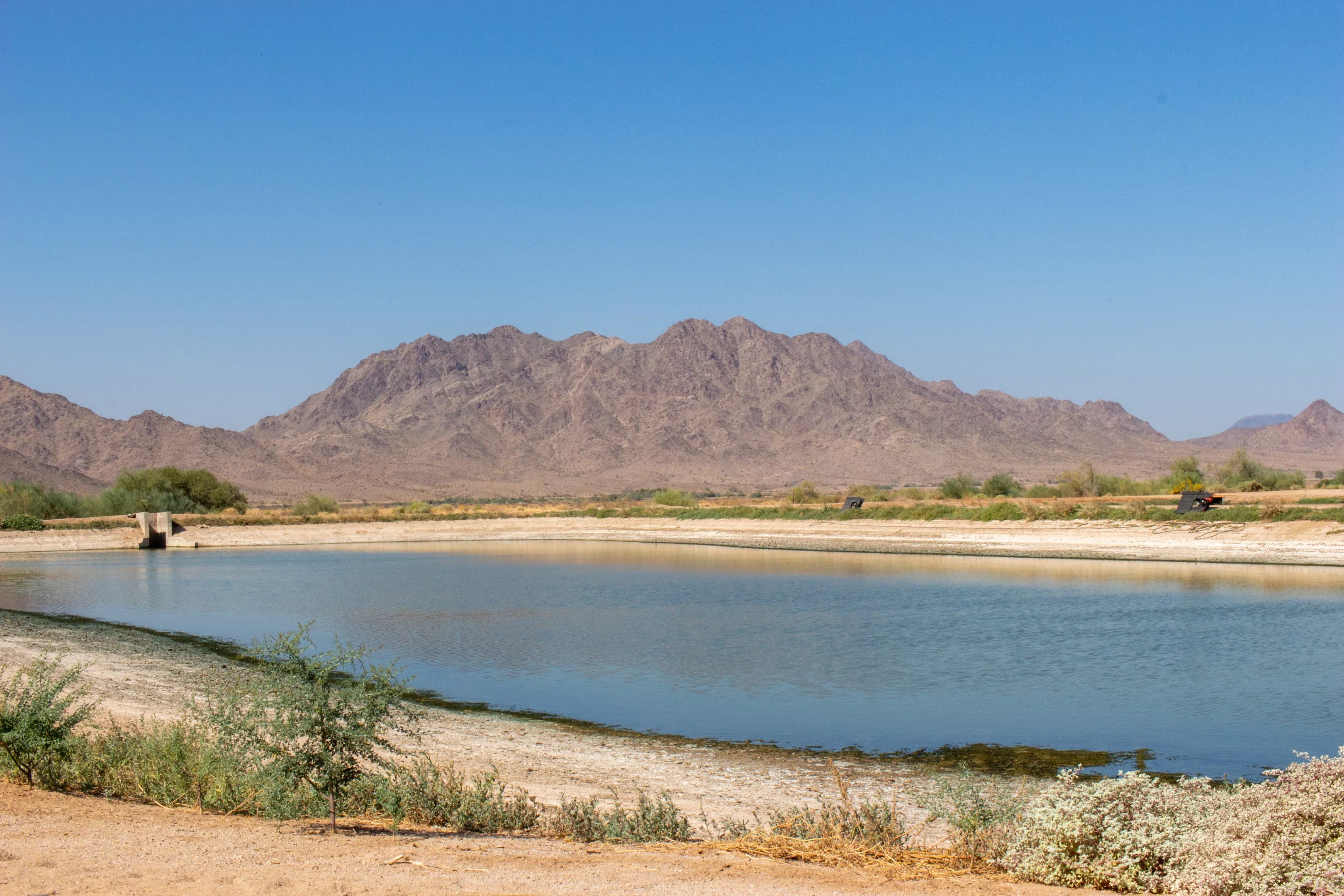
Kelly Kalmbach

Audio By Carbonatix
Welcome to Table Scraps, a monthly series on the growing problem of food waste and what some eateries, officials, farms, institutes, and everyday people are doing right. This isn’t a guilt trip, just a way to unpack initiatives attempting to reduce kitchen waste and food loss, as more than 40 percent of all food is wasted in the U.S. We’re exploring backyard composting to city programs, restaurant tips to technology, and anything related to this global issue. Heat up those leftovers, and settle in.
The city of Gila Bend hosts an annual Desert Shrimp Festival the first weekend of November (although not this year, obviously).
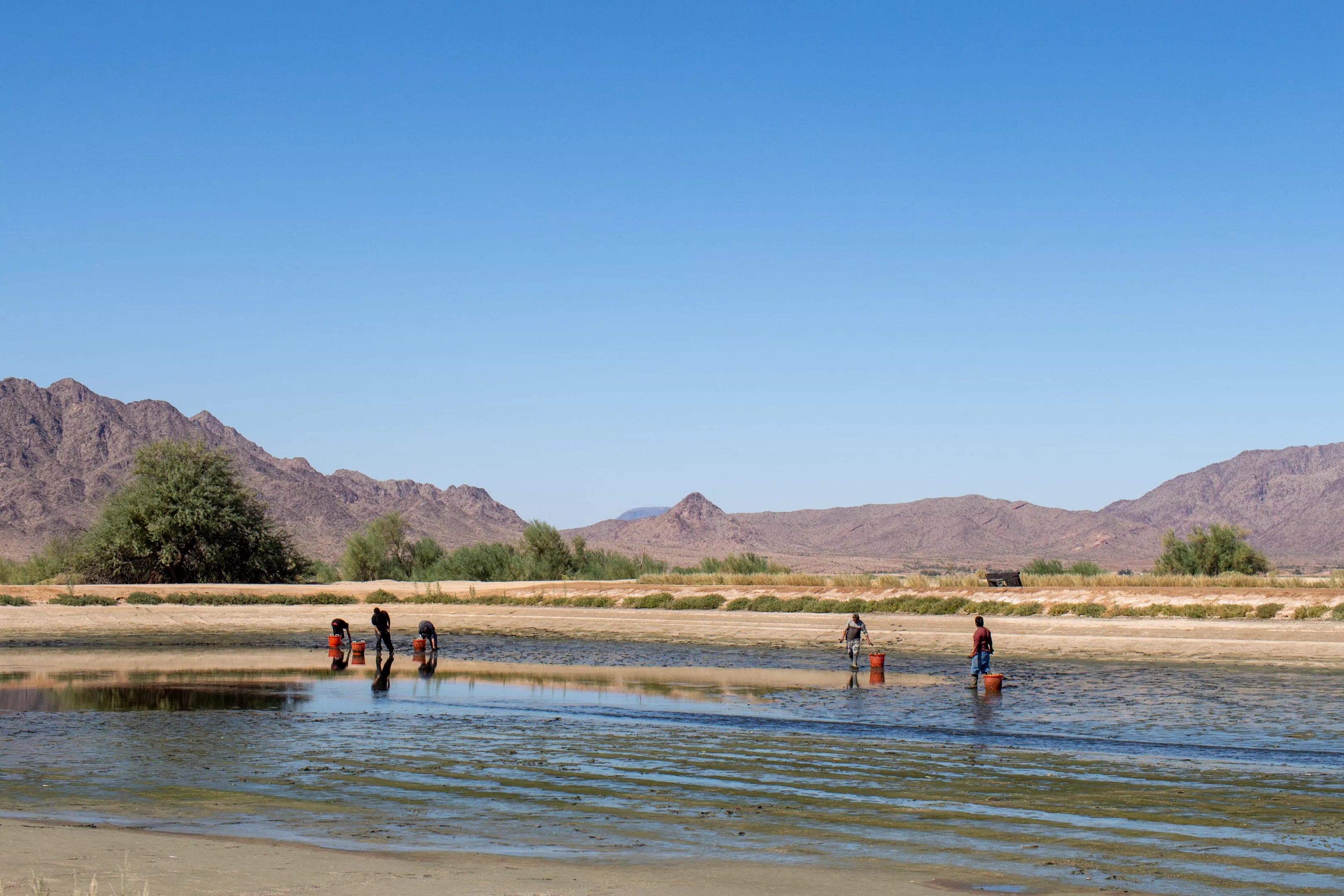
Harvesting shrimp from the (temporary) ponds in Gila Bend.
Kelly Kalmbach
That might sound a bit absurd; most people understandably do not associate shrimp with desert sands. But some form of a shrimp farm has been set along Old U.S. 80 since 1995. The old one was called Desert Sweet Shrimp. Now, the acreage belongs to Arizona Desert Shrimp (ADS), an operation that got going in May 2020 and happens to be on the absolute razor’s edge of sustainable shrimp farming.
“We’ve developed a technology where we can grow shrimp in a container,” says chief financial officer Michael Cunha. “We can control the complete environment, from the water, the PH, the oxygen levels, and we can recirculate that water by taking it out, recleaning it, and bringing it back in.”
Cunha met me at ADS’s processing facility on Pima Street in Gila Bend and drove us both to the farm, which kind of felt like a spy movie. On the way, he explained that ADS’s technology was developed by Dr. Maurice Kemp, a research scientist with a Ph.D. in medical microbiology specializing in virology. He and ADS’s small team worked with Texas A&M University, where ADS as a company began to form, at what was then the largest shrimp research facility in the world. (Hurricane Harvey wiped it out in 2015.) Their technology not only produces shrimp (the most popular seafood item in America, according to the National Fisheries Institute). It also aims to reduce the use of water and land.
“What we want to do,” Cunha said, “is review every particular part of raising shrimp and say, ‘How can we best use those resources and to make them be able to be reused?'”
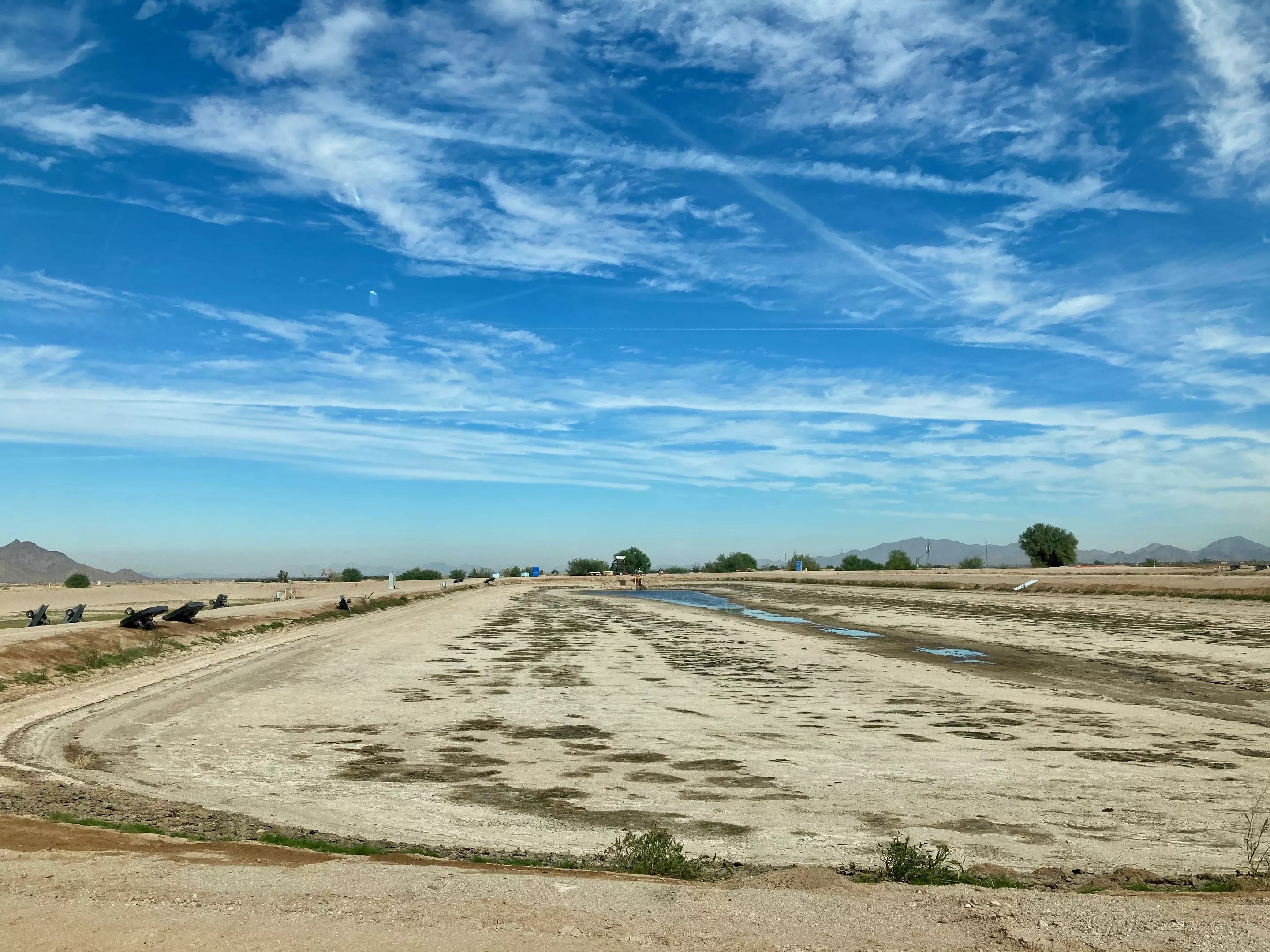
NBD but ADS is aiming to restore a couple million acres of land.
Lauren Cusimano
Reducing water, preserving land
Timing aligned this spring for ADS to take over the ponds and farmland now called West Valley Farms, located along the Gila River in the Gila Basin.
“In the end, it doesn’t matter where you’re at in the world,” Cunha said of the location. “If you’re in the middle of the desert, you can grow sustainable high-quality great tasting product.”
The land sits above a very large aquifer maintained by the Hassayampa River. The aquifer has a saline content of about 1.6 to 5.5 parts per thousand – too salty to be drinkable.
“We’re not taking personal water,” Cunha said. “We’re taking water that can’t be used by humans.”
Water is drawn from the aquifer, brought up through wells, put into tanks to be treated via reverse osmosis, then used in various ways for shrimp production.
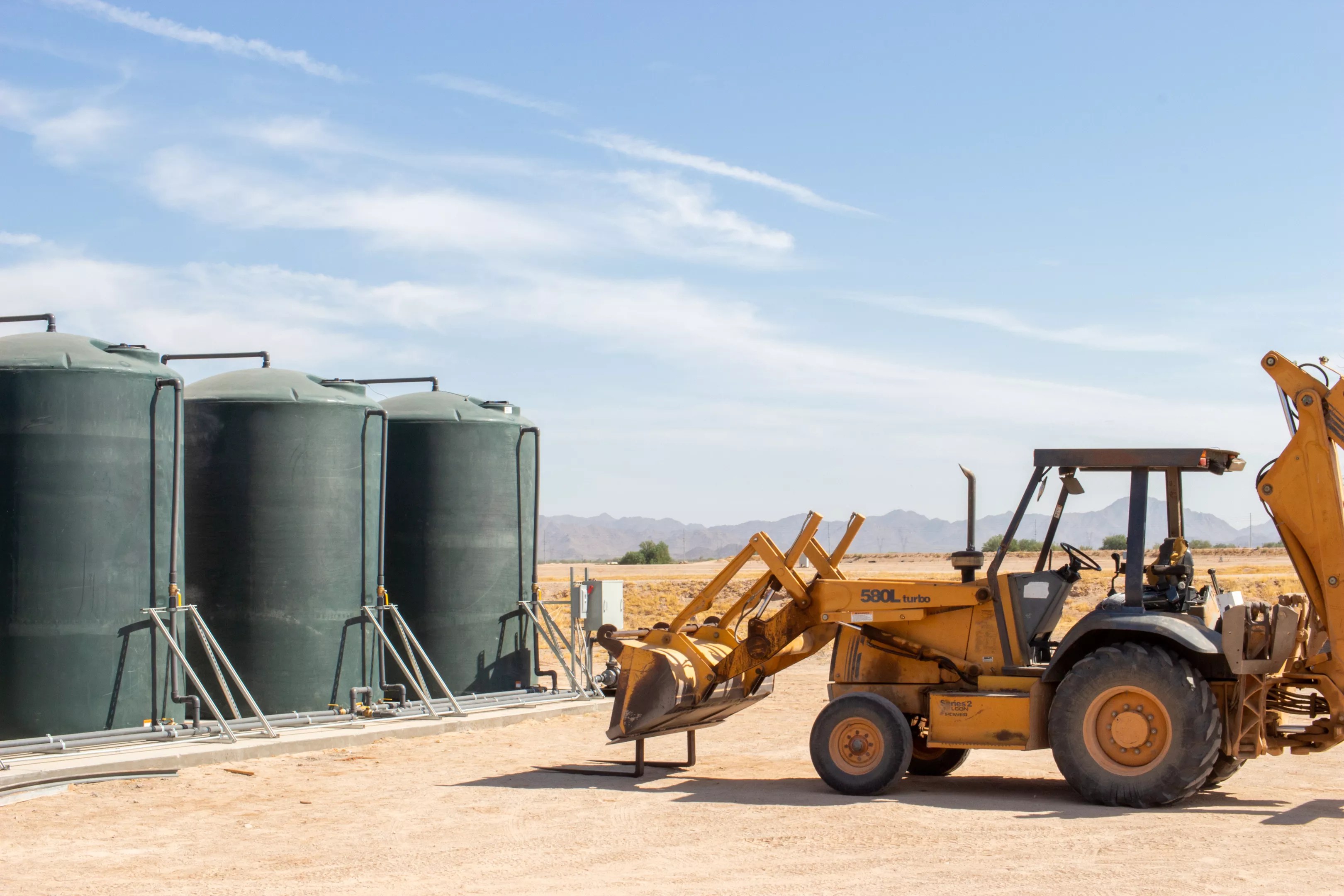
Tanks with well water getting the reverse osmosis treatment.
Kelly Kalmbach
The shrimp cycle starts with PLs (postlarvae, millions of which ADS has purchased from a pathogen-free hatchery in the United States). They’re put into raceways – cement dugouts in the farm’s greenhouse, filled with water that moves counterclockwise. “Think about you’re at the Kentucky Derby, but you’re in a helicopter right above,” Cunha said.
The baby shrimp first have to acclimate to ADS’ well-water salt levels. Most shrimp are grown in a saline environment of 20 to 30 parts per million (ppm), but ADS grows theirs in water with 2.5 ppm. When shrimp are large enough for survivability, they’re placed in ponds for eventual harvest. The first big shrimp harvest wrapped in early November and the next is slated for early fall 2021.
Cunha showed me nine ponds, about two acres each, mostly drained. For now, when the ponds are drained after the harvest, the water is piped into a nearby lake that’s used by local farmers for irrigation. (You could see olive trees and cotton fields in the distance.) All but two percent of the water is used either for growing shrimp or harvesting agricultural crops, and that two percent loss primarily comes from evaporation.
But the ponds, Cunha explained, are “a steppingstone to generation two technology.” This spring, ADS will begin construction on permanent containers for shrimp production. Eventually, the company will require only containers and raceways to harvest shrimp.
Cunha said ADS aims, in part, to sunset the practice of devoting acreage to shrimp production – or at least greatly reduce it. A lot of land is being used for shrimp ponds around the world, and much of it is rendered near-useless due to the water’s concentration of salt and bacteria. Meaning if the shrimp farmers decide to cease operations, there may be no getting that land back to how it was.
“We’re really wasting land by growing shrimp in ponds,” he said.
With its container technology, ADS hopes to revolutionize this particular corner of the seafood industry.
“Just imagine a billion acres of ponds around the world being used to grow shrimp,” Cunha said. “If we can take half of that property out and put them into the technology that we’re using, we’re going to have 500 million acres of land that can be cleaned up and reused for other, better purposes than destroying it for the growing of shrimp.”
And the ADS team plans to practice what it preaches.
Those 18 acres – the nine, two-acre ponds – will eventually be cleaned out, filled in with fresh earth, and returned to their natural form or be used for agriculture.
With this, ADS hopes to set an example for other shrimp farmers and production companies, motivating them to move away from ponds by demonstrating the effectiveness of the container system.
“Who knows, maybe over a period of 20 years we can convert 200 or 300 million acres,” Cunha said. “Just think of that: Now you have land that can be used for better things, or it can go back to its natural habitat.”
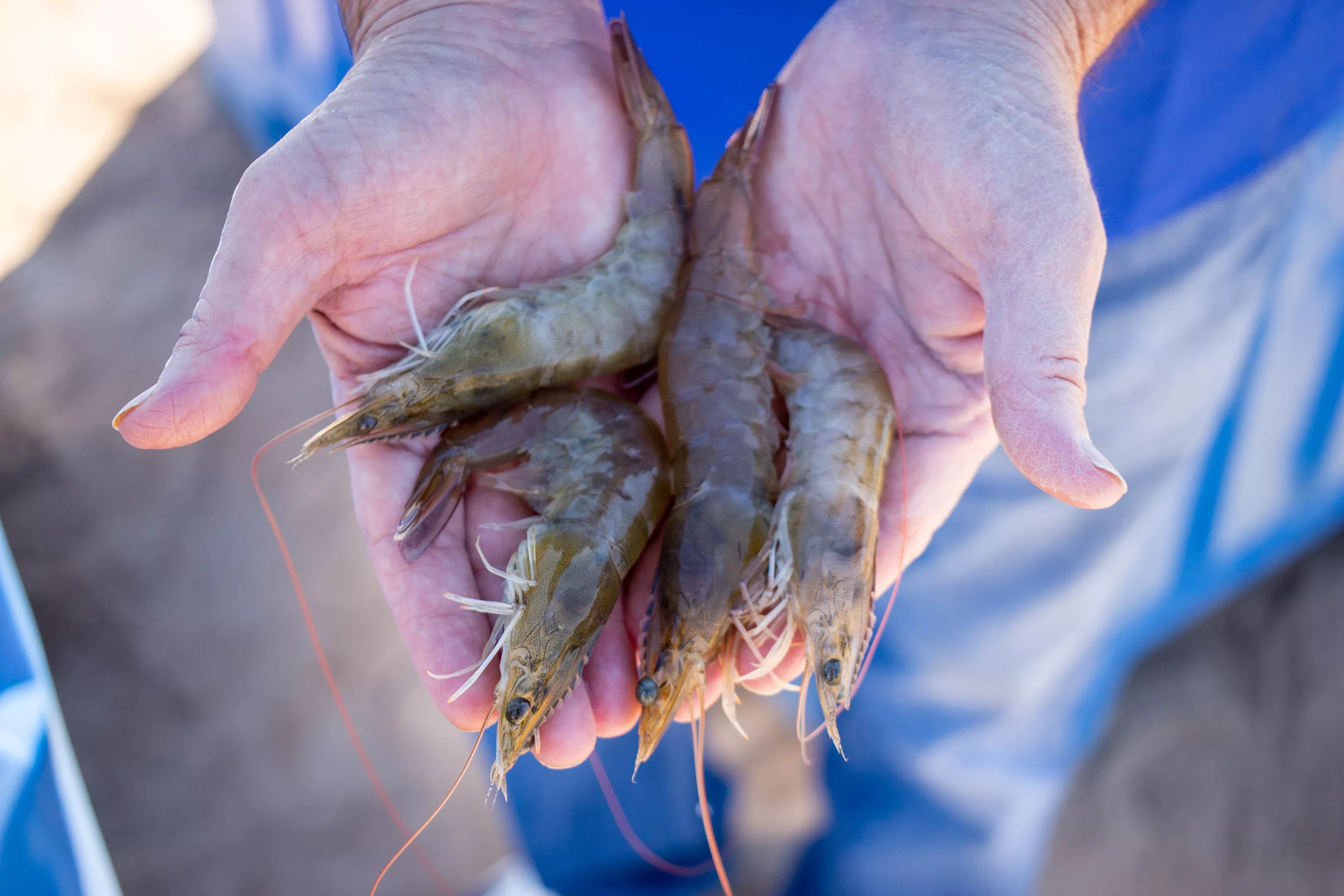
Even the shrimp feed is designed with sustainability in mind.
Kelly Kalmbach
Other fancy innovations
ADS has also created its own formula to nourish the shrimp. It’s called a floating feed.
“Shrimp are bottom feeders, but it’s amazing how quickly they realize the feed is floating,” Cunha said.
The shrimp make their way up to the surface, retrieve the feed, and dive to the bottom to eat it. In ADS’ system, whatever the shrimp don’t eat floats back to the top, as opposed to sinking to the bottom. This helps preserve the land beneath: When feed sinks, it can create a bacterial environment.
By monitoring this process, the ADS team can also better estimate the amount of unconsumed food.
“When this system is maximized, we know exactly how much feed to put in,” he said. “We get it to a point where there’s no feed coming out to be wasted. All the food that we put in there is being consumed.”
Its sustainability efforts are laudable, but ADS is also a business, and it is in the business of selling high-quality shrimp. “We’re the Caymus wine of shrimp,” Cunha joked.
Most shrimp consumers are accustomed to shrimp grown in waters with 20 to 30 ppm of salt. But because ADS controls all elements of the production environment, chefs that buy from ADS can tailor their ppm: 10 ppm, 16.5 ppm, 25 ppm – go nuts, whatever you want.
Due to the lack of light in deeper waters, most shrimp are black and don’t become pink until cooked. But some shrimp, primarily from Japan, can be blue. The meat’s the same, but the color gives the impression that the shrimp is somehow different or better. It also lets people know where the shrimp came from – blue equals Japan.
Challenge accepted, ADS says.
“We can create any color we want,” Cunha said. “We may do an aqua color. So, when that shrimp comes out, eventually people around the world are going to say, “The aqua shrimp, that’s Arizona!'”